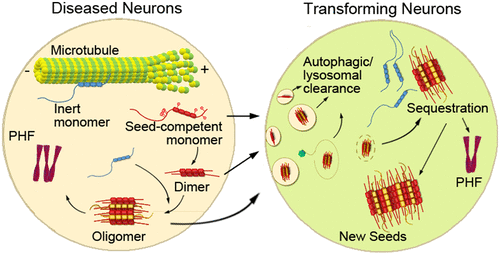当前位置:
X-MOL 学术
›
ACS Chem. Neurosci.
›
论文详情
Our official English website, www.x-mol.net, welcomes your feedback! (Note: you will need to create a separate account there.)
Pathological Changes of Tau Related to Alzheimer's Disease.
ACS Chemical Neuroscience ( IF 5 ) Pub Date : 2018-10-23 , DOI: 10.1021/acschemneuro.8b00457 Dandan Chu 1 , Fei Liu 2
ACS Chemical Neuroscience ( IF 5 ) Pub Date : 2018-10-23 , DOI: 10.1021/acschemneuro.8b00457 Dandan Chu 1 , Fei Liu 2
Affiliation

|
Alzheimer's disease (AD), the most common form of dementia, is characterized by extracellular β-amyloid plaques and intracellular neurofibrillary tangles (NFTs), which are considered as major targets for AD therapies. However, no effective therapy is available to cure or prevent the progression of AD up until now. Accumulation of NFTs, which consist of abnormally hyperphosphorylated tau, is directly correlated with the degree of dementia in AD patients. Emerging evidence indicates that the prion-like seeding and spreading of tau pathology may be the key driver of AD. In the past decades, greater understanding of tau pathway reveals new targets for the development of specific therapies. Here, we review the recent research progress in the mechanism underlying tau pathology in AD and briefly introduce tau-based therapeutics.
中文翻译:

Tau的病理变化与阿尔茨海默氏病有关。
阿尔茨海默氏病(AD)是痴呆症的最常见形式,其特征在于细胞外β淀粉样斑块和细胞内神经原纤维缠结(NFT),它们被认为是AD治疗的主要靶标。但是,到目前为止,尚无有效的疗法可治愈或预防AD的进展。NFTs的积累由异常的过度磷酸化的tau组成,与AD患者的痴呆程度直接相关。越来越多的证据表明,tau病理的the病毒样播种和扩散可能是AD的主要驱动力。在过去的几十年中,对tau途径的更多了解揭示了开发特定疗法的新目标。在这里,我们回顾了tau病理在AD中的机制的最新研究进展,并简要介绍了基于tau的疗法。
更新日期:2018-10-11
中文翻译:

Tau的病理变化与阿尔茨海默氏病有关。
阿尔茨海默氏病(AD)是痴呆症的最常见形式,其特征在于细胞外β淀粉样斑块和细胞内神经原纤维缠结(NFT),它们被认为是AD治疗的主要靶标。但是,到目前为止,尚无有效的疗法可治愈或预防AD的进展。NFTs的积累由异常的过度磷酸化的tau组成,与AD患者的痴呆程度直接相关。越来越多的证据表明,tau病理的the病毒样播种和扩散可能是AD的主要驱动力。在过去的几十年中,对tau途径的更多了解揭示了开发特定疗法的新目标。在这里,我们回顾了tau病理在AD中的机制的最新研究进展,并简要介绍了基于tau的疗法。



























 京公网安备 11010802027423号
京公网安备 11010802027423号